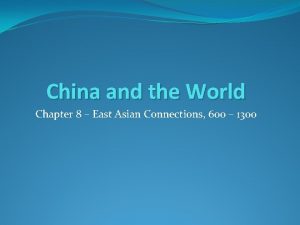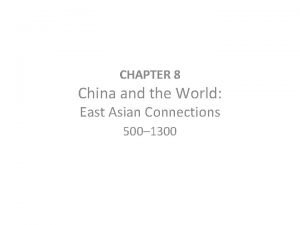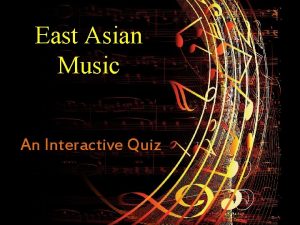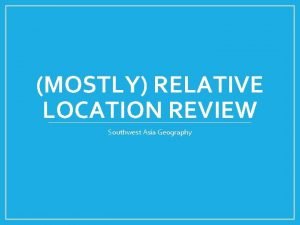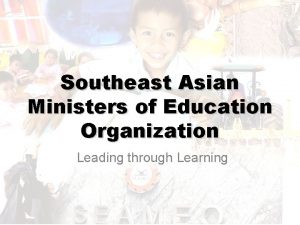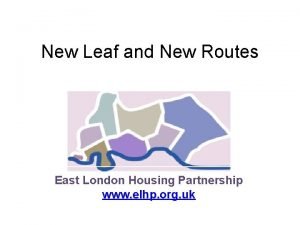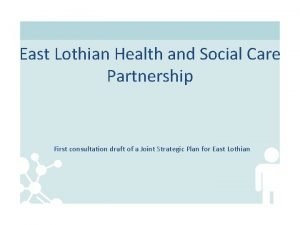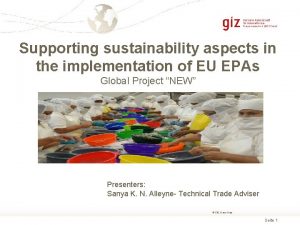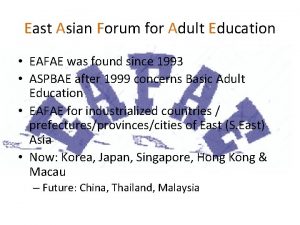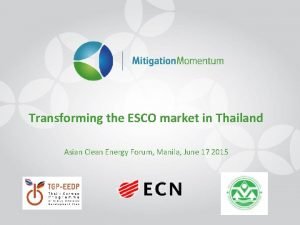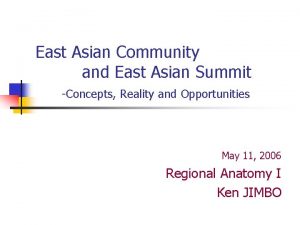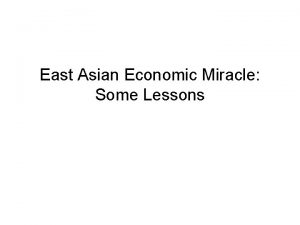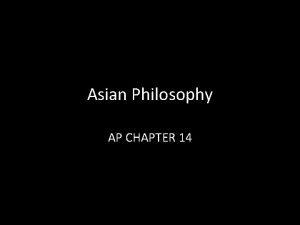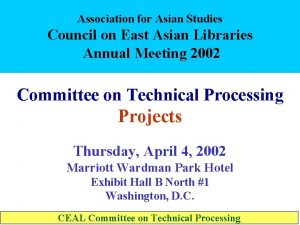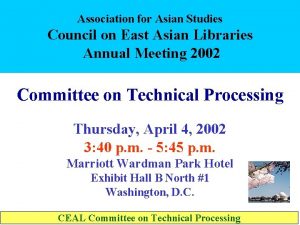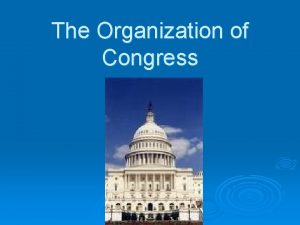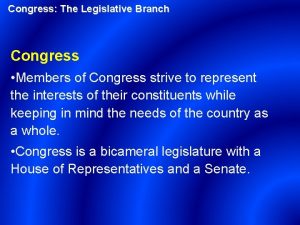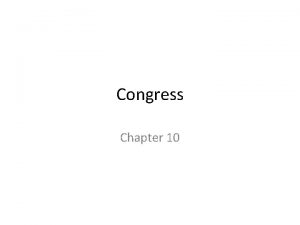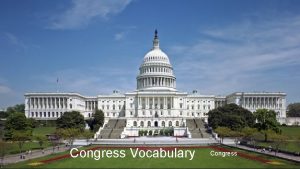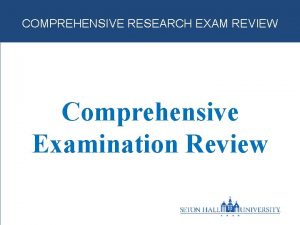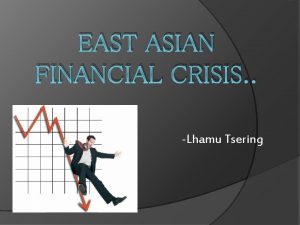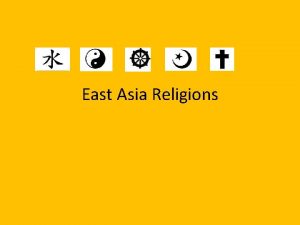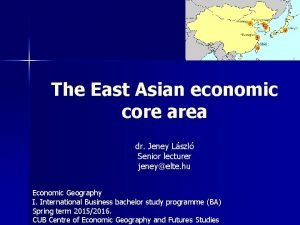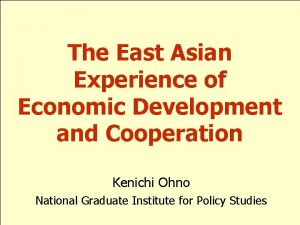5 th East Asian Congress Comprehensive Economic Partnership



















- Slides: 19

5 th East Asian Congress Comprehensive Economic Partnership: East Asia and Beyond? Mahani Zainal Abidin Institute of Strategic and International Studies, Malaysia 3 – 4 December 2007

Outline • • • Introduction Regional Integration and Community Building Market-Driven Processes: Trade and Investment Links • State-Driven Processes • Cooperation based on Common Interests • Conclusion: The Way Forward 2

Introduction • Establishment of an East Asian regional grouping – APT (East Asia) and APS (East Asia Plus) : two routes both with ASEAN as the vital and irreplaceable part of and EA regional grouping • Kind of regional grouping envisaged – EAVG: community-building and economic dimensions • Use of word community – different connotations • APEC – Economic partnership through open regionalism Ø Explore the effective and most likely comprehensive economic integration with East Asia as the core driver 3

Regional Economic Integration and Community Building • Regions integrate through market-led and state-led processes • Market-led: Ø Emergence of network of businesses • State-led: Ø Standard economic European Community based model; Ø Focus is an economic community – single market type concept 4

Regional Economic Integration and Community-Building • State-led APT or APS – need to bear in mind the community envisaged by ASEAN Economic partnership is a component of the broader regional integration Is ASEAN is a model for regional integration? if use ASEAN integration as the starting point, then ASEAN Plus needs to build on what ASEAN has achieved and concur with what ASEAN aspires to achieve; 5

Regional Integration and Community. Building: • ASEAN’s vision – ASEAN Community ØThree Pillars: § ASEAN Economic Community (AEC) § ASEAN Socio-cultural Community (ASCC) § ASEAN Security Community (ASC) ØScope of integration compared with the European Community ØEconomic integration compared with the European Community 6

Market-Driven Processes • Trade and Investment Linkages ØFDI – due to the fragmentation of production process & the evolution of regional production networks ØJapan’s role ØGrowing role of China ØRole of other sources countries ØTrade linkages: growth in intra-firm and intra-regional trade due to the exports and imports of MNCs in the region 7

Intra-Regional Trade Share, 1995 -2006 (%) Region 1995 2000 2001 2002 2003 2004 2005 2006 ASEAN (10) 21. 1 22. 7 22. 2 22. 7 24. 4 24. 9 25. 7 ASEAN+3 37. 0 37. 4 37. 3 38. 4 39. 5 39. 1 39. 0 ASEAN+6 40. 4 40. 6 40. 8 41. 6 42. 7 43. 1 8

Market-Driven Processes • Trade Links ØRise of China: - emergence of new trade triangles involving ASEAN, source countries and China; - New division of labor between ASEAN and China; ØRelative intensity of trade among ASEAN with the Plus Three and Plus Six 9

ASEAN-5’s Export Intensity Index and Import Intensity Index Partners Export Intensity Index Import Intensity Index 1990 1995 2000 2005 Plus 3 2. 04 1. 45 1. 56 1. 46 2. 75 2. 52 1. 76 1. 46 Plus 6 1. 88 1. 39 1. 55 1. 48 2. 52 2. 31 1. 63 1. 34 10

State-driven Processes • APT cooperation began in Dec 1997, institutionalized in 1999 Ø Implementation of measures of the EASG: § Establishment of the APT Study Group on Facilitation and Promotion of Exchange of People and HR Development; § Establishment of the East Asia Think-tanks (NEAT); § Establishment of an East Asia Forum; § Formation of East Asian Business Council • East Asia Summit in 2005 § Inclusion of India, Australia and New Zealand § Second Summit in January 2007, Third Summit in November 2007 11

In the mean time, proliferation of statedriven economic partnership processes • FTAs involving ASEAN Ø Ø ASEAN-wide arrangements – China, South Korea, Japan and India Ø Ø Thailand – Australia concluded, Thailand –NZ concluded; Japan – bilaterals with Singapore, Malaysia, Thailand the Philippines; Singapore –Australia concluded, Singapore –NZ concluded; Ø Malaysia - still negotiating with Australia and New Zealand, concluding with Pakistan • China, Japan and Korea have concluded a number of FTAs with countries outside the East Asian region 12

Economic Cooperation • Common Interests Financial Stability – triggered by the Asian Financial Crisis - Chiang Mai Initiative – a regional financing arrangement - Economic Review and Policy Dialogue - Exchange data on bilateral capital flows on a voluntary basis - Asian Bond Markets Initiatives (ABMI) - APT Research Group 13

Other common interests • Non-traditional security; –Transnational crimes such as human and drug trafficking, money laundering, terrorism, sea piracy, arms smuggling, international economic crime and cyber crime • Energy security cooperation • Pandemic threats - Avian Flu and SARS • Environmental concerns - deforestation, forest fires, chemical pollution, air pollution, marine and water contamination, global warming 14

APEC economic partnership is on voluntary basis § Progress of APEC economic integration is slow § Scope of economic liberalisation has not expanded significantly § Focus of APEC has widen to beyond economic issues e. g. on climate change in the last APEC meeting in Australia § Economic interests and links of APEC members are too diverse 15

Conclusion • Diversity of countries in East Asia Plus and Asia Pacific • Current economic linkages are strongest within the APT • Deepening existing linkages need government-togovernment initiatives to overcome barriers to trade such as regulations, customs, exchange rates, product standards and other institutions – lower trade costs and increase trade and investment within APT first. 16

Conclusion • APT has established areas of cooperation that serve a common purpose and support economic partnership • Fundamental premise for the APT Goal of community building is the promotion of the welfare and well-being of the people and the realization of the East Asian vision of cooperative “peace, prosperity and progress”. 17

Conclusion Potential problems of expanding beyond East Asia • Increase in size and complexities of integration § Membership issues? § Increasing diversity with more members § Experience of ASEAN efforts at economic integration shows the difficulty of accelerating the pace of integration – dealing with the issue of development gap among member countries • APT has well established market and state led processes for further integration 18

Thank you
 Chapter 8 china and the world
Chapter 8 china and the world Chapter 8 china and the world east asian connections
Chapter 8 china and the world east asian connections Which of the following statements about changgo is correct
Which of the following statements about changgo is correct Relative location of israel
Relative location of israel Southeast asian ministers of education
Southeast asian ministers of education East ayrshire health and social care partnership
East ayrshire health and social care partnership South east strategic partnership for migration
South east strategic partnership for migration East london housing partnership
East london housing partnership Sussex msk partnership east
Sussex msk partnership east East lothian health and social care partnership
East lothian health and social care partnership Epa economic partnership agreement
Epa economic partnership agreement East is east and west is west
East is east and west is west Horizontal movement of air
Horizontal movement of air Near east vs middle east
Near east vs middle east Difference between economic growth and economic development
Difference between economic growth and economic development Economic growth vs economic development
Economic growth vs economic development Economics unit 1 lesson 2 difficult choices
Economics unit 1 lesson 2 difficult choices Compare and contrast the vocal styles of india & israel.
Compare and contrast the vocal styles of india & israel. China adult forum
China adult forum Asian esco
Asian esco
